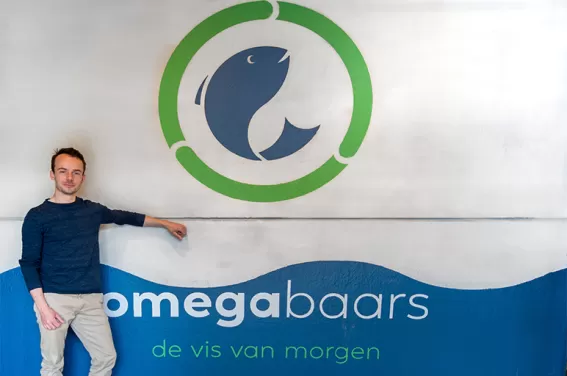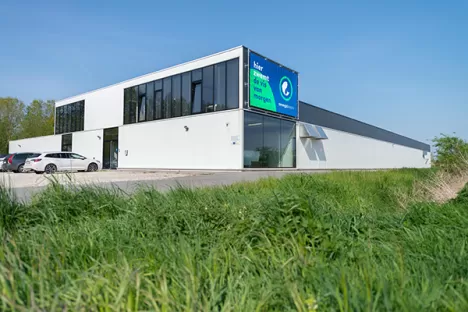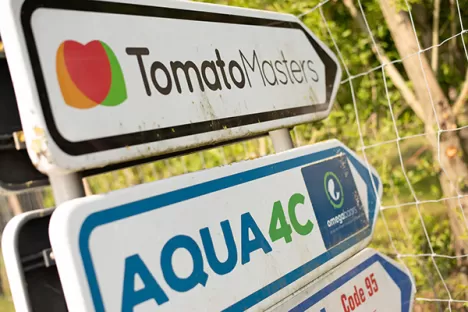
Aqua4C - The world’s most sustainable fish farm

“We see Air Liquide as full partners who are on the same page as us on efficiency and sustainability.”
In Kruisem, Belgium, of all places, there’s a unique fish farm. The inconspicuous Aqua4C building – not by chance located right next to a tomato farm – is home to a series of tanks with a combined capacity of around 1 million litres of fresh water. As well as almost 40 tonnes of omega perch...
Founder, and Doctor of Biology, Stijn Van Hoestenberghe learned the trade first at a sea bass farm in Spain and then a shrimp farm in the Seychelles. Back in Belgium, KU Leuven asked him to devote his doctorate to the search for a species of fish suitable for sustainable farming.
The fish of tomorrow is... a vegetarian
The result of the research is the omega perch or scortum barcoo, which owes its name to its high content of omega 3 fatty acids. Stijn has also been developing a totally plant-based diet for the omega perch. The vegetarian farmed fish is born...
The story of the omega perch and Aqua4C has gradually evolved from a research project into a commercial fish farm. Stijn Van Hoestenberghe left Aqua4C to focus on other projects, but the research programme continues unabated.
And the winner is…
“The omega perch is the perfect fish for sustainable farming," says Operations Manager Charles Fransman. "It’s an omnivore, which means you can feed it plant-based – and therefore sustainable – food. The omega perch is also a warm-water fish, which is an advantage for its economic profitability (warm-water fish grow faster than cold-water fish – ed.).”
“In that respect, it’s also important that the omega perch is a social fish that likes to live in schools. This means that you can breed a relatively large number of fish in a tank without stressing the fish. And our vegetarian fish also had to be a freshwater fish, because then we could supply it sustainably with fresh water.”
Tasty and flexible
But as well as all these requirements regarding sustainability and economic profitability, the fish also had to be attractive for the consumer. “We set up several blind taste tests – with various preparations made by well-known chefs such as Jeroen Meus – and each time it turned out that the fish was very well appreciated. The taste of the omega perch is somewhere between trout and sea bass, but when it’s fried with butter it’s very reminiscent of sole. It’s a very firm fish, so it can also be smoked or roasted on the barbecue without falling apart.”
The price (about €20/kilo for whole fish or €30/kilo filleted) is slightly higher than that of sea bass and sea bream but cheaper than sole. “Consumer research shows that customers are happy to pay a premium for healthy and sustainably farmed fish. The fish is currently only available in Belgium at fishmongers and in Carrefour supermarkets, but it’s our intention to scale up production in the short term, so that the fish becomes much more widely available, and in other countries too.”
Complementary sustainability
Its vegetarian preferences alone make the omega perch a sustainably farmed fish, but that’s not all. Aqua4C has developed a revolutionary 'complementary sustainability' model, which means that the fish farm uses no water and is more-or-less energy-neutral.
To make this possible, Aqua4C has set up a collaboration with the tomato farm next door. The greenhouses collect large quantities of rainwater, a small proportion of which is used to fill the Aqua4C basins. After use, the water is extensively filtered and then delivered back to the tomato farm. The filtered residue is used as fertiliser and can also go for biogas production.
In the five coldest months of the year, the residual heat from the tomato farm's combined heat and power unit is used to heat the fish tanks. The same source also produces more than enough residual energy to cover Aqua4C's electricity needs. The result of all this is an exceptionally sustainable fish.
Production 2.0
“At the end of 2019, after detailed analysis, we decided to upgrade some of our systems," Charles continues "One of the most important of these was our oxygen supply system. Since our fish need oxygen to survive, it goes without saying that the operational reliability of the oxygen system is crucial.”
“Up to that point, we used an oxygen compressor. The problem is that the reliability of such a compressor is not optimal. Every time the compressor went down, we had to call on a back-up system – bundles of oxygen cylinders – and hope that the compressor could be repaired before the oxygen from the back-up system ran out. A very stressful business. The system also needed a fair amount of maintenance and was not very flexible: if, for some reason we temporarily wanted a faster flow of oxygen, the compressor couldn’t provide it.”
Liquid oxygen
After consulting a number of leading aquaculture specialists – including American professor Thomas Losordo – it was decided to switch to a system based on liquid oxygen. “Hospitals don't rely on oxygen compressors, so why should we?” says Charles.
“By that time, the collaboration with Air Liquide had already begun. We were looking for a new oxygen cylinder supplier for our back-up system and Air Liquide offered a very competitive total cost of ownership. Air Liquide were immediately able to help us optimise costs and improve efficiency. Their knowledge and commitment were the decisive reasons for us to make the switch.”
Safer operation and more flexible
“Then we started talking about liquid oxygen and replaced the oxygen compressor with Air Liquide’s solution based on pure liquid oxygen and oxygen injectors. This system is much more reliable – not least because there are hardly any moving parts – and it offers much more flexibility in terms of oxygen production. We can also increase the pressure (up to 8 bar) when necessary, making the whole operation much more efficient.”
“And of course, we would like to obtain our oxygen in the most sustainable way possible. In that respect, too, the system based on liquid oxygen scores considerably better. Air Liquide can also offer green oxygen (CO2-neutral production and transport – ed.).”
“Looking at the overall cost picture, the Air Liquide solution turns out to be no more costly than the traditional setup with an oxygen compressor, while we can also make full use of the advantages of course. In short, we now have a reliable source for our oxygen, and we can sleep easy again. That wasn’t always the case before.”
Partnership
“We now see Air Liquide as full partners who are on the same page as us on efficiency and sustainability. It feels good to be able to work with people who know how a fish farm operates and can give us good advice.”
“We’ll soon be sitting down with Air Liquide to discuss plans for our second fish farm. We plan to scale up production significantly from a new location by 2024. And, from then on, we also want to handle the processing of the fish – filleting and packaging and suchlike – ourselves. That will help us maximise quality control right down to the point of sale. But what is certain is that we will once again choose Air Liquide’s oxygen solution.”
Want to know more about our pure oxygen applications?

